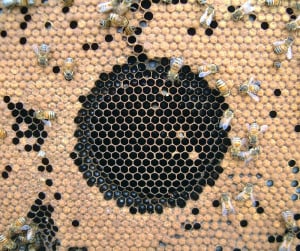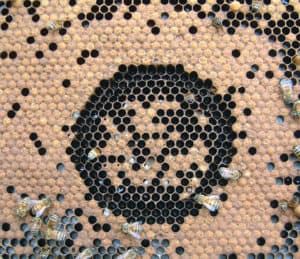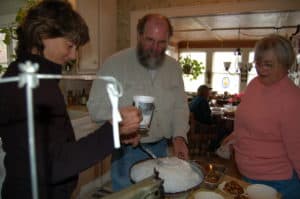Hygienic behavior is a trait that correlates with resistance to chalkbrood, American Foulbrood, and Varroa. Bees with the trait are able to detect, uncap, and remove infected pupae before they become infectious, slowing the spread of disease and the population growth of the mite. It is a trait with multiple genes involved influencing the uncapping and removal behaviors and olfaction. The olfaction genes indicate that the bees need to be able to smell the diseased or dead pupa (or absence of a healthy smell) in order to remove it.

To test for the trait, I remove a frame with capped brood, twist a 3” PVC pipe into the brood, count the number of cells that aren’t sealed brood (there are about 160 cells in a 3” circle), then pour 10 oz of liquid nitrogen into the pipe to freeze-kill the brood. After the tube thaws, it can be removed, and the frame placed back into the colony. Check the frame in 24 hours and count the number of cells not cleaned by the bees. The more cells uncapped and pupae removed, the more hygienic the colony. More information can be found on the U of MN bee lab website (check out “free-bees” for a poster on testing). Any leftover liquid nitrogen can be used to make ice cream (wear protective gloves).

This hygienic trait can be found in all stocks of bees, although only at low levels if the bees have not been selected for it. Breeding this trait into a stock of bees takes about 5 years of persistently selecting colonies with the most hygienic queens as breeder colonies to raise daughter queens, and as drone mother colonies to rear lots of hygienic drones. Hygienic drones are key to producing hygienic queens, so if you do rear queens, make sure to flood your mating areas with drones from good colonies.
It is critical to choose colonies for other traits first, and then test that pool for hygienic behavior. Starting with good stock initially helps ensure you don’t end up with a scrappy, although hygienic, bee stock. Hygienic bees can be just as productive and docile as unselected bees, as long as you start with a good population.
Hygienic behavior was one of the traits I tested for the queen producers in Jan-Feb. Many of the queen producers have their own lines of bees with desirable traits, and that is not something I wanted to try to mess with. Their bees work for them, so introducing a whole new set of genetics could set them back years of hard work. I ask the bee breeders to mark colonies that they would consider potential breeders, and I tested those. There were two queen producers whose results blew me away by testing much higher than I expected. One has selected for hygienic behavior in the past, but the other is just extremely rigorous about never choosing a breeder with any disease what-so-ever and has a good tracking system. Overall, I was really impressed by the queen producers and am looking forward to the next round of hygienic testing next Jan-Feb.
